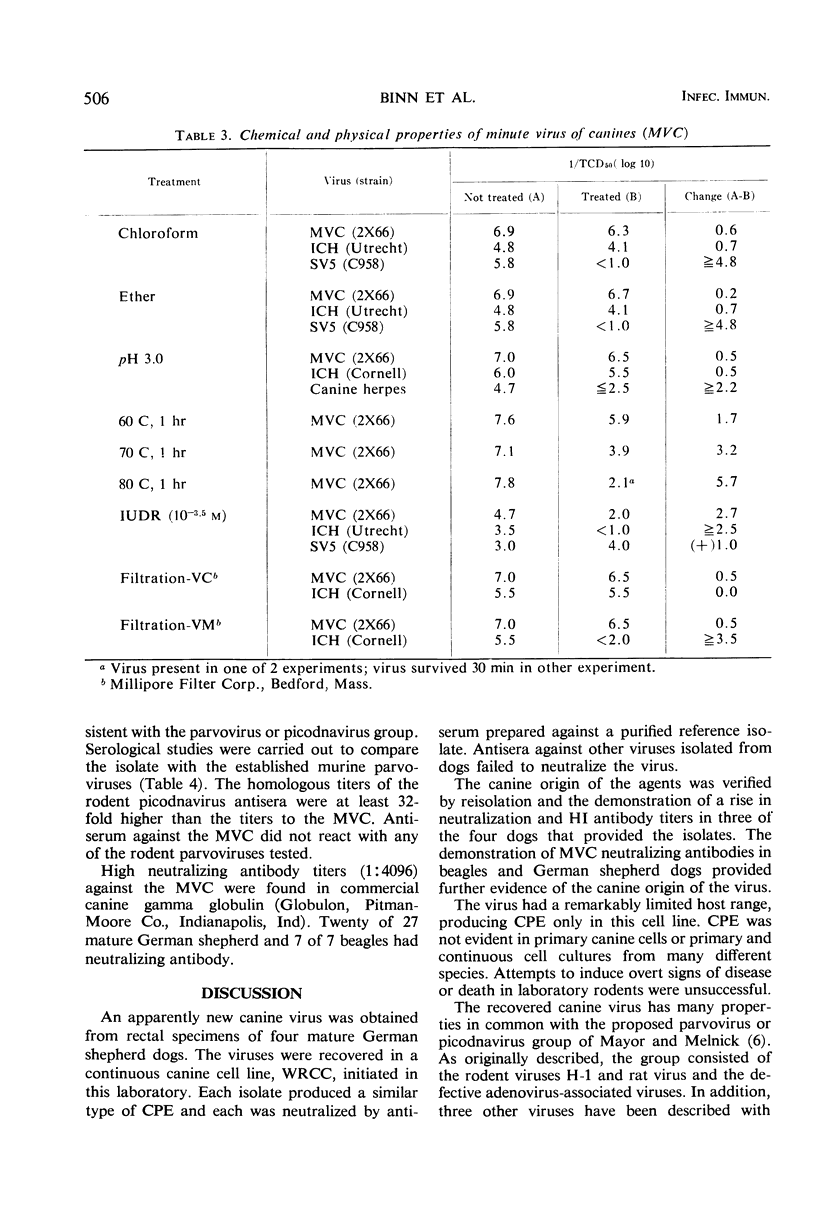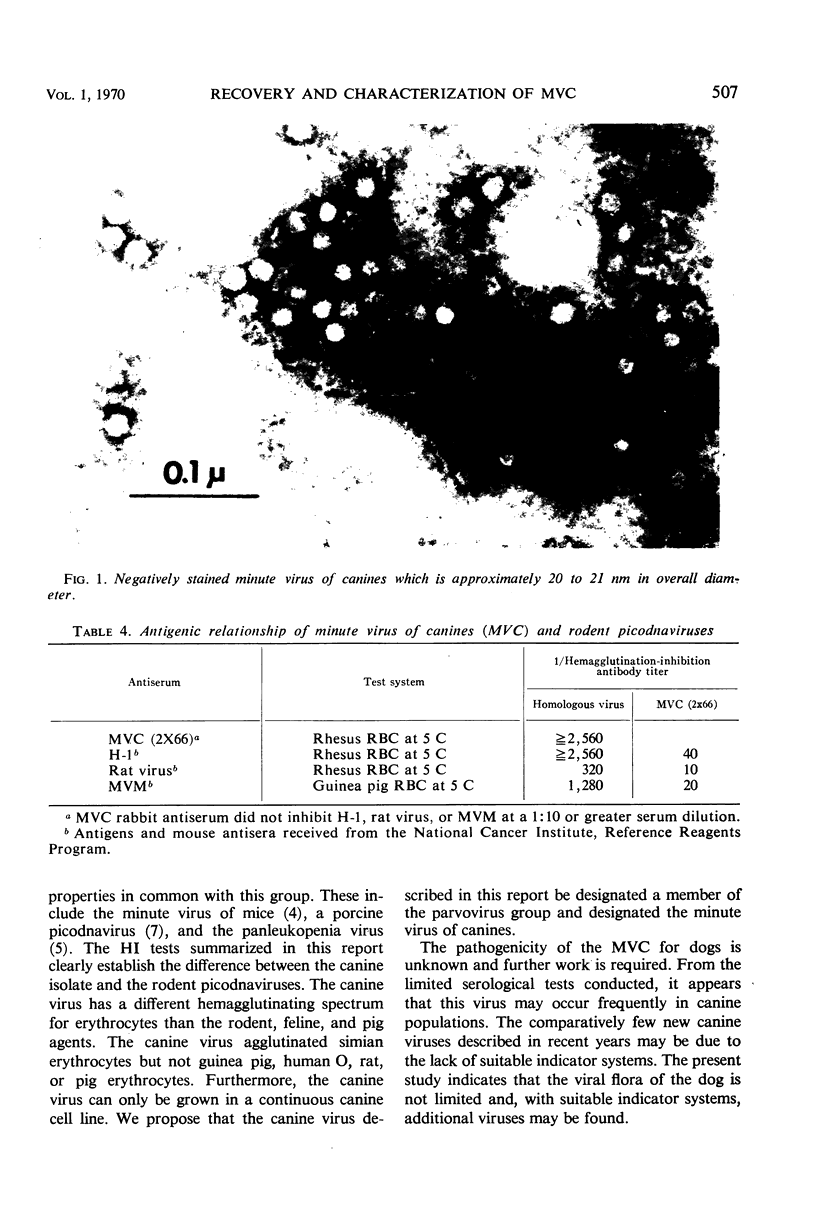Abstract
Four antigenically related transmissible agents were recovered from canine fecal specimens. The agents produced cytopathic effects in a continuous dog cell line developed in this laboratory. Increased antibody titers were demonstrated in three of the four dogs which provided the isolates. The virus did not produce cytopathic effects in primary canine kidney or thymus cell cultures, or in cell cultures of human, simian, porcine, bovine, feline, and murine origin. The agent is resistant to ether, chloroform, and heat treatment, and the growth of the virus is inhibited by 5-iodo-2-deoxyuridine. After acridine orange staining, green fluorescent intranuclear inclusions are seen in infected cell cultures. By electron microscopy, the virions measure approximately 20 to 21 nm in overall diameter and are present in the nuclei of infected cells. These properties are consistent with membership in the parvovirus or picodnavirus group. The agent hemagglutinates rhesus red blood cells at 5 C and by hemagglutination-inhibition tests could be readily distinguished from H-1, rat virus, and the minute virus of mice. Canine gamma globulin contains high titers of neutralizing antibody and neutralizing antibody was found in a high percentage of military dogs and in beagles of a breeding colony.
Full text
PDF





Images in this article
Selected References
These references are in PubMed. This may not be the complete list of references from this article.
- BRENNER S., HORNE R. W. A negative staining method for high resolution electron microscopy of viruses. Biochim Biophys Acta. 1959 Jul;34:103–110. doi: 10.1016/0006-3002(59)90237-9. [DOI] [PubMed] [Google Scholar]
- Binn L. N., Eddy G. A., Lazar E. C., Helms J., Murnane T. Viruses recovered from laboratory dogs with respiratory disease. Proc Soc Exp Biol Med. 1967 Oct;126(1):140–145. doi: 10.3181/00379727-126-32386. [DOI] [PubMed] [Google Scholar]
- Binn L. N., Lazar E. C., Rogul M., Shepler V. M., Swango L. J., Claypoole T., Hubbard D. W., Asbill S. G., Alexander A. D. Upper respiratory disease in military dogs: bacterial, mycoplasma, and viral studies. Am J Vet Res. 1968 Sep;29(9):1809–1815. [PubMed] [Google Scholar]
- Crawford L. V. A minute virus of mice. Virology. 1966 Aug;29(4):605–612. doi: 10.1016/0042-6822(66)90284-4. [DOI] [PubMed] [Google Scholar]
- Johnson R. H. A search for parvoviridae (picodnaviridae). Vet Rec. 1969 Jan 4;84(1):19–20. doi: 10.1136/vr.84.1.19. [DOI] [PubMed] [Google Scholar]
- MOLLENHAUER H. H. PLASTIC EMBEDDING MIXTURES FOR USE IN ELECTRON MICROSCOPY. Stain Technol. 1964 Mar;39:111–114. [PubMed] [Google Scholar]
- Mayor H. D., Melnick J. L. Small deoxyribonucleic acid-containing viruses (picodnavirus group). Nature. 1966 Apr 16;210(5033):331–332. doi: 10.1038/210331a0. [DOI] [PubMed] [Google Scholar]
- Mayr A., Bachmann P. A., Siegl G., Mahnel H., Sheffy B. E. Characterization of a small porcine DNA virus. Arch Gesamte Virusforsch. 1968;25(1):38–51. doi: 10.1007/BF01243088. [DOI] [PubMed] [Google Scholar]
- SABATINI D. D., BENSCH K., BARRNETT R. J. Cytochemistry and electron microscopy. The preservation of cellular ultrastructure and enzymatic activity by aldehyde fixation. J Cell Biol. 1963 Apr;17:19–58. doi: 10.1083/jcb.17.1.19. [DOI] [PMC free article] [PubMed] [Google Scholar]
- STARR T. J., POLLARD M., TANAMI Y., MOORE R. W. Cytochemical studies with psittacosis virus by fluorescence microscopy. Tex Rep Biol Med. 1960;18:501–514. [PubMed] [Google Scholar]
- Spertzel R. O., Huxsoll D. L., McConnell S. J., Binn L. N., Yager R. H. Recovery and characterization of a herpes-like virus from dog kidney cell cultures. Proc Soc Exp Biol Med. 1965 Dec;120(3):651–655. doi: 10.3181/00379727-120-30615. [DOI] [PubMed] [Google Scholar]



